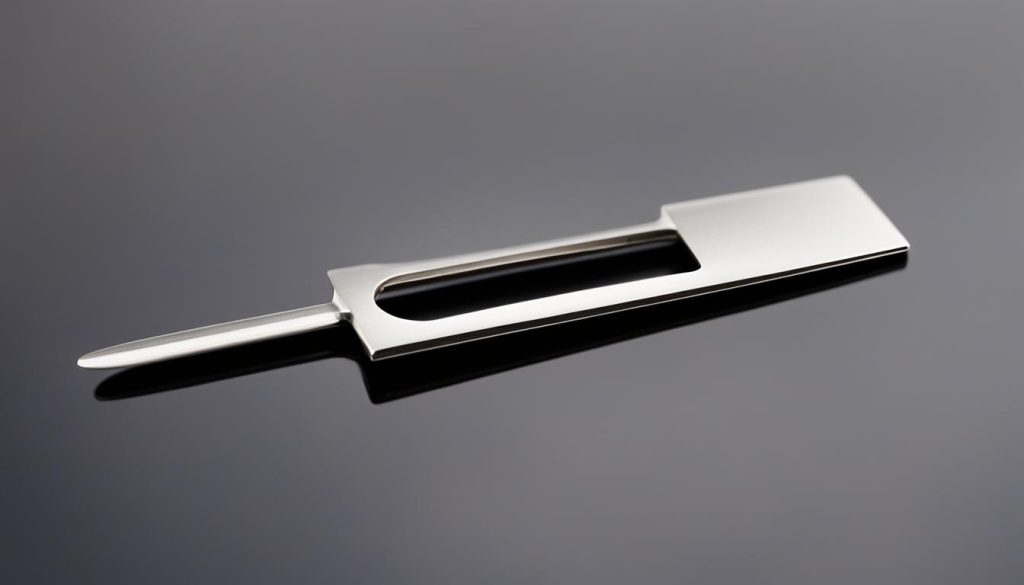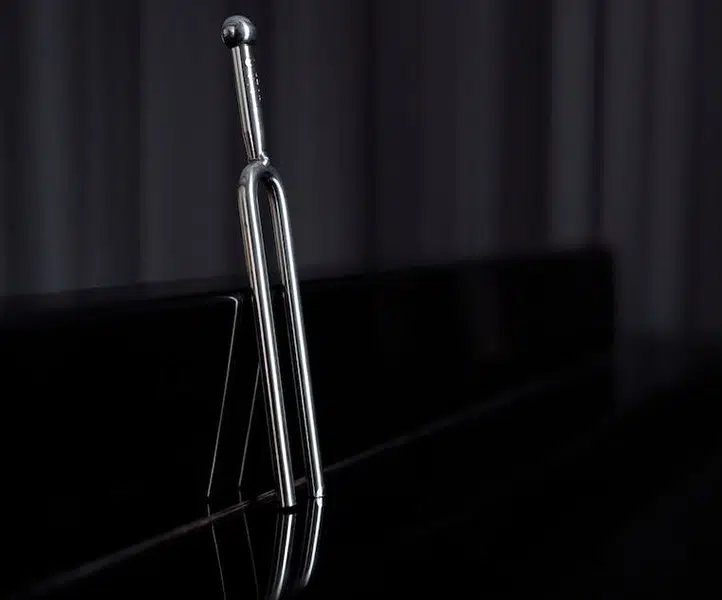
Tuning forks are fascinating instruments that allow us to explore the physics of sound and resonance.
When a tuning fork is struck, it vibrates and produces a pure musical tone. The duration of the vibration of a tuning fork’s handle depends on various factors, including the length of the prongs.
Shorter prongs produce higher pitch sounds and tend to vibrate at a higher frequency when struck.
The handle length of the tuning fork also affects the duration of the vibration. The vibrations can last for several seconds, and the specific duration can vary depending on the specific tuning fork.
Let’s find out how long a tuning fork vibrates when it handles.
Content
The Science Behind Tuning Fork Vibrations
When a tuning fork is struck, its prongs start to vibrate rapidly. These vibrations are so fast that they are not visible to the naked eye.
The speed of the tuning fork’s vibrations is known as its frequency, which is measured in hertz (Hz) or vibrations per second.
The frequency of the vibrations determines the pitch of the note produced by the tuning fork.
Higher frequency vibrations result in higher pitch sounds, while lower frequency vibrations produce lower pitch sounds.
This relationship between frequency and pitch is a fundamental principle of the physics of sound.
But how do these vibrations actually occur?
The physics of tuning fork vibrations involves the interaction between the vibrating prongs and the surrounding air molecules.
When the tuning fork is struck, the force causes the prongs to move back and forth rapidly. As the prongs move, they push and pull the air molecules around them, creating areas of compression and rarefaction.
These areas of compression and rarefaction travel through the air as a sound wave, which we perceive as sound.
The Science Behind Tuning Fork Vibrations
In summary, tuning fork vibrations are the result of the rapid movement of its prongs.
The frequency of the vibrations determines the pitch of the sound produced, with higher frequency vibrations resulting in higher pitch sounds.
The physics behind tuning fork vibrations involves the interaction between the vibrating prongs and the surrounding air molecules, which creates sound waves that travel through the air.
“The frequency of the vibrations determines the pitch of the sound produced, with higher frequency vibrations resulting in higher pitch sounds.”
Understanding the science behind tuning fork vibrations helps us appreciate the intricate relationship between frequency, pitch, and sound production.
This knowledge is not only fascinating in the realm of physics, but also has practical applications in fields such as music, medicine, and scientific research.
Continue reading to discover the factors that can affect the duration of tuning fork vibrations and the practical applications of tuning forks in various industries.
| Key Points |
|---|
| Tuning fork vibrations are generated by the rapid movement of the prongs. |
| The frequency of the vibrations determines the pitch of the sound produced. |
| The physics of tuning fork vibrations involve the interaction between the vibrating prongs and the surrounding air molecules, creating sound waves. |
Factors Affecting the Duration of Tuning Fork Vibrations
Several factors can significantly influence the duration of tuning fork vibrations. The material of the tuning fork handle is one such factor.
Different materials possess varying properties that can result in variations in vibration duration. For example, a tuning fork with a handle made of a dense metal may vibrate for a longer duration compared to one made of a lighter material.
The weight and composition of the handle directly affect the way energy is transferred and dissipated during vibration, thus influencing the overall duration.
Another factor that can impact the duration of tuning fork vibrations is the striking force applied.
The force with which the tuning fork is struck can influence the amplitude of the vibrations, leading to variations in duration. Applying a harder strike can produce a louder sound and potentially prolong the vibrations.
Conversely, a softer strike may result in a shorter duration of vibrations.
The striking force is a crucial variable to consider when studying the behavior of tuning forks and the resulting sound produced.
Additionally, the use of a resonance box can have a significant effect on the duration of tuning fork vibrations. A resonance box is a hollow enclosure that is designed to amplify and focus sound waves.
When a tuning fork is placed inside a resonance box, the sound produced is reflected and reverberates within the box, creating an echo effect.
This prolonged interaction of sound waves can result in a longer duration of vibrations.
The resonance box acts as a sound chamber, enhancing the acoustic properties and extending the vibrational period of the tuning fork.
These factors, among others, can influence the duration of vibrations and the overall sound produced by a tuning fork.
The material of the handle, the striking force applied, and the use of a resonance box are all critical considerations when studying the behavior of tuning forks.
By understanding these factors, researchers and enthusiasts can gain deeper insights into the physics of sound and further explore the fascinating world of tuning fork vibrations.
Table: Comparison of Tuning Fork Handle Materials
| Material | Description | Vibration Duration |
|---|---|---|
| Steel | Durable and dense metal | Longer |
| Aluminum | Lightweight and malleable metal | Shorter |
| Wood | Natural and resonant material | Variable |
| Plastic | Lightweight and inexpensive material | Shorter |
Practical Applications of Tuning Fork Vibrations
When it comes to practical applications, tuning forks have proven to be valuable tools in various fields. Let’s explore some of the ways they are utilized:

Tuning Fork in Science Experiments
Scientists often use tuning forks in experiments to study the fundamental properties of sound, such as pitch and volume.
By striking a tuning fork and placing it on different objects, researchers can observe how different materials and surfaces affect the sound produced.
This allows for a better understanding of acoustics and the behavior of sound waves.
Tuning Fork in Medicine
In the field of medicine, tuning forks are commonly used in hearing tests to assess the function of the middle and inner ear.
Different frequencies of tuning forks are utilized to evaluate vibratory sensation and hearing.
These tests provide valuable information about a person’s auditory health and can help diagnose hearing loss or other auditory disorders.
Tuning Fork in Hearing Tests
Aside from their use in medical hearing tests, tuning forks also play a role in clinical tests that assess sensory perception.
Common tests such as the Rinne test and Weber test utilize tuning forks to evaluate the difference in perception between air and bone conduction of sound, helping to determine the presence and type of hearing loss.
Vibratory sensation testing, which assesses the duration and intensity of tuning fork vibrations, is also employed to evaluate sensory perception.
Clinical Tests Involving Tuning Fork Vibrations
Tuning forks are not only fascinating instruments for exploring the physics of sound, but they also play a crucial role in clinical tests related to hearing and sensory perception.
These tests help medical professionals assess various aspects of auditory health and sensory function. Let’s take a closer look at some of the common clinical tests involving tuning fork vibrations.
Rinne Test
The Rinne test is a widely used procedure to evaluate the difference in perception between air conduction and bone conduction of sound.
In this test, a tuning fork is placed on the mastoid process behind the ear and then next to the external ear canal.
The patient is asked to indicate when they can no longer hear the sound.
By comparing the patient’s responses to air conduction and bone conduction, healthcare providers can determine if there is conductive hearing loss (when sound is heard better through bone conduction) or sensorineural hearing loss (when sound is heard better through air conduction).
Weber Test
The Weber test is another valuable tuning fork test used in the evaluation of hearing loss. In this test, a tuning fork is struck and placed on the midline of the patient’s forehead or on the crown of the head.
The patient is then asked to indicate in which ear they hear the sound louder or if they hear it equally in both ears.
The results of the Weber test can help identify whether there is a unilateral (one-sided) conductive or sensorineural hearing loss, or if the hearing loss is bilateral (affecting both ears) with equal severity.
Vibratory Sensation Testing
In addition to assessing hearing, tuning forks are also utilized to evaluate vibratory sensation in clinical settings.
The duration and intensity of the vibrations produced by a tuning fork are assessed to evaluate the patient’s ability to perceive sensory stimuli.
Healthcare providers may apply a vibrating tuning fork to various parts of the body, such as the fingertips or bony prominences, and ask the patient to indicate when they feel the vibration stop.
This type of testing can provide valuable information about a person’s sensory perception and aid in the diagnosis and management of certain conditions.
| Tuning Fork Test | Purpose |
|---|---|
| Rinne Test | Evaluates difference between air and bone conduction |
| Weber Test | Determines unilateral or bilateral hearing loss |
| Vibratory Sensation Testing | Evaluates sensory perception |
These clinical tests involving tuning fork vibrations are valuable tools in assessing hearing function, identifying hearing loss, and evaluating sensory perception.
They provide healthcare professionals with essential information for accurate diagnosis and appropriate treatment.
Through these tests, tuning forks continue to play a significant role in clinical practice and contribute to the overall well-being of patients.
Advancements in Tuning Fork Technology
As technology continues to advance, new innovations in tuning fork technology have emerged, expanding their practical applications in various industries. One such advancement is the development of MEMS gyroscopes.
These gyroscopes utilize microscopic tuning fork-like structures within a sensor to detect angular velocity and orientation.
With high sensitivity and precision, MEMS gyroscopes find applications in satellite and space communication systems, enabling accurate navigation and positioning.
Another breakthrough in tuning fork technology is the use of piezoelectric plate gyroscopes. These gyroscopes employ a PZT (lead zirconate titanate) plate made of piezoelectric material to generate vibrations.
Unlike traditional tuning forks, piezoelectric plate gyroscopes require lower drive voltage while delivering enhanced performance.
This technology holds promise in various fields, including robotics, aerospace, and remote sensing.
These advancements in tuning fork technology have revolutionized industries by improving functionality and performance.
MEMS gyroscopes and piezoelectric plate gyroscopes have provided more accurate and reliable solutions for navigation, orientation, and sensing applications.
With ongoing research and development, we can expect further advancements in tuning fork technology, enabling even more innovative and practical uses in the future.
